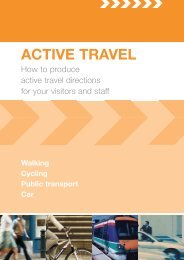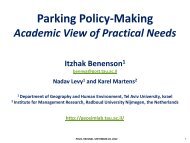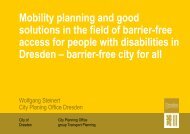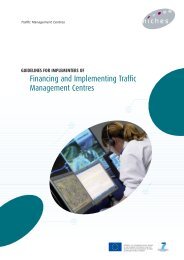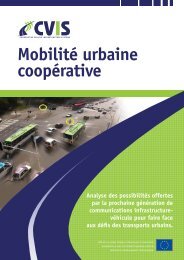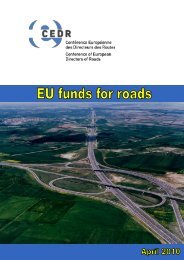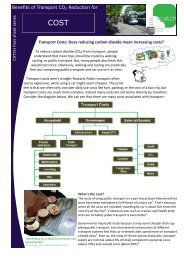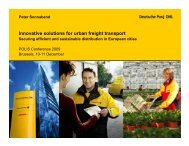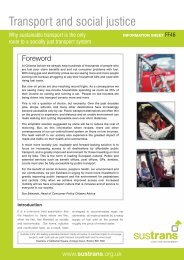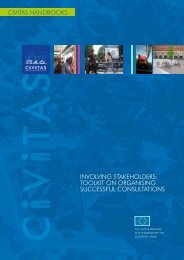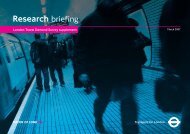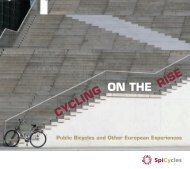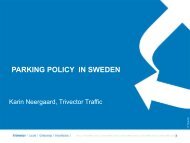Sustainable Urban Transport Planning - Tallinn
Sustainable Urban Transport Planning - Tallinn
Sustainable Urban Transport Planning - Tallinn
Create successful ePaper yourself
Turn your PDF publications into a flip-book with our unique Google optimized e-Paper software.
<strong>Sustainable</strong> <strong>Urban</strong> <strong>Transport</strong> <strong>Planning</strong><br />
Methodology put to practice<br />
• Aarne Rentik, PILOT Project Manager<br />
<strong>Tallinn</strong> <strong>Transport</strong> Department<br />
• Sylwia Klatka<br />
Managing Director of ConVoco Ltd.<br />
15th of March 2007
Facts about <strong>Tallinn</strong><br />
•Population – 398 753; aggl: 550 000<br />
• Area – 159,2 km 2 ; aggl: 43333 km 2<br />
• City Districts – 8; aggl: 24 loc. govern.<br />
• Unemployment rate in <strong>Tallinn</strong>- 4,2%<br />
• Economic sector: information<br />
technology light, textile and food<br />
industry; service and government sector
Examples of public transport fleet
Building partnerships and managing transfer of know-how<br />
in the fields of:<br />
• clean transport solutions<br />
• integrated transport in cities<br />
Selected projects:<br />
ConVoco Ltd<br />
• BIOGASMAX: Biogas as Vehicle Fuel –<br />
Market Expansion to 2020 Air Quality<br />
• INTRASEA: Inland <strong>Transport</strong> on Sea Routs<br />
• TELLLUS: <strong>Transport</strong> & Environment Alliance for <strong>Urban</strong><br />
<strong>Sustainable</strong> <strong>Transport</strong><br />
• PILOT: <strong>Planning</strong> Integrated Local <strong>Transport</strong>
Current mobility characteristics in <strong>Tallinn</strong><br />
- 413 private cars per thousand in Estonia and 478 in 2006;<br />
- Separate lines for busses 6,9 km; for trams 9,6 km<br />
- Pay parking lots in centre:<br />
About 4300; from the 1st of April about 8300<br />
Places in private pay parking lots: about 5600 (out of roads)<br />
Share of pay parking lots in centre – 55%<br />
- Proposals for Park & Ride sites and new dedicated bus lines<br />
(later in presentation)<br />
- The flows of goods from and to 4 ports going through the city<br />
centre. No adequate bypasses (e.g. on west-east direction)<br />
yet.<br />
- Congestions...<br />
- Average speed of PT – 17,4 km/per hour
Location creates directions of urban sprawl
Connecting speeds by cars
Modal split in <strong>Tallinn</strong> 2006 (number of trips)<br />
Pedestrians/<br />
Cyclists<br />
30%<br />
Cars<br />
39%<br />
Public <strong>Transport</strong><br />
31%
Modal split in <strong>Tallinn</strong> 2006 (Vehiclekm)<br />
•In <strong>Tallinn</strong><br />
Pedestrians/<br />
Cyclists<br />
Public 3%<br />
<strong>Transport</strong><br />
34%<br />
Cars<br />
63%<br />
•On the border of <strong>Tallinn</strong><br />
Public<br />
<strong>Transport</strong><br />
19%<br />
Cars<br />
81%
Public transport in <strong>Tallinn</strong> in 2006<br />
Vehiclekm, thousands<br />
Tram-traffic<br />
11%<br />
Trolley-traffic<br />
22%<br />
Bus-traffic<br />
67%
<strong>Sustainable</strong> approach to transport<br />
<strong>Sustainable</strong> transport planning<br />
is not necessarily an issue of big investments<br />
- it’s a way of thinking<br />
Lille, France
Sustainability–needs for paradigm shifts
Creation of image of an active<br />
transport mode?
PILOT: <strong>Planning</strong> Integrated Local <strong>Transport</strong><br />
• PILOT project demonstrates the preparation of<br />
<strong>Sustainable</strong> <strong>Urban</strong> <strong>Transport</strong> Plans (SUTP) in four<br />
European cities: Braila, Evora, Lancaster and <strong>Tallinn</strong><br />
• PILOT will proposes tools, guidelines and<br />
recommendations for other European regions and<br />
cities
<strong>Sustainable</strong> <strong>Urban</strong> <strong>Transport</strong> Plan: objectives<br />
• To ensure accessibility<br />
• Reduce the negative impact on citizens<br />
• Reducing negative environmental impacts<br />
• Improving the cost-effectiveness<br />
• Contributing to the enhancement of the<br />
attractiveness and quality of the urban environment<br />
and urban design.
Examples in <strong>Tallinn</strong><br />
• Low floor PT<br />
• Improved modal links: integrated planning system<br />
– Public transport centre<br />
• Wi-fi internet connection in school busses<br />
• Smart and flexible ticketing system, e.g. m-Ticketing<br />
• Real-time monitoring system for cross roads<br />
• ICT options<br />
• Land use and transport planning
IT connected with software for building and<br />
optimising traffic schedules – PIKAS<br />
Viru bus terminal<br />
information<br />
system, traffic<br />
light system<br />
Automatic<br />
passenger<br />
counting<br />
system<br />
PT priority<br />
system<br />
Mobile<br />
operators<br />
SMS<br />
DB<br />
INTERNET<br />
Route<br />
planning<br />
tool<br />
WAP<br />
Timetables<br />
Public transport<br />
map on internet<br />
Languages
Another innovative action<br />
Ticketing system<br />
• 1983 – integrated ticketing system<br />
• 2002 – 17 different types of tickets<br />
• 2002 – payment by mobile phone, pilot project<br />
• 2002 – integrated ticket for commuter train and <strong>Tallinn</strong><br />
public transport<br />
• 2004 – ID-ticket (virtual ID-card-based payment and control<br />
system) and M-ticket (payment by mobile phone)<br />
• 2005 – 41 different types of tickets<br />
• 2005 – integrated ticketing system withneighbouring<br />
Viimsi municipality
Phone<br />
On-line sales and ticket checks<br />
Mobile<br />
Population Registry<br />
Internet<br />
e-Tickets<br />
Cash<br />
Person must possess and show an<br />
ID-card when buying or verifying a ticket
Priority System with Park&Ride proposals
SUTP Process<br />
• A participatory approach<br />
• A pledge for sustainability<br />
• An integrated approach<br />
• A focus on the achievement of measurable targets<br />
• A move towards cost internalisation<br />
• A circle of policy making and implementation<br />
• 5 Tasks, 10 Missions, plan adoptions and approval,<br />
plan review
OVERVIEV OF A COMPLETE SUTP<br />
PROCESS – TIMING PERSPECTIVE
Process of Pilot project<br />
Figure 5: Indicative SUTP schedule – based on a total duration of 3 years<br />
SUTP phases Duration Period<br />
Overall sustainable development strategy<br />
20 –30 years<br />
horizon<br />
Building a strategic/operational framework 1 year M -12 M 0<br />
Running the SUTP process 2 years M 0 M 24<br />
Status analysis and scenario building<br />
10 Months<br />
M 0<br />
M 10<br />
Vision, objectives, targets<br />
9 Months<br />
M 4<br />
M 12<br />
Action and budget plan<br />
10 Months<br />
M 13<br />
M 22<br />
Assignment of responsibilities & resources<br />
2 Months<br />
M 23<br />
M 24<br />
Monitoring and evaluation mechanism<br />
15 Months<br />
M 6<br />
M 22<br />
Plan adoption and approval 1 Month M 24 M 24<br />
Monitoring and evaluation of<br />
implementation: annual progress<br />
New action and budget plan<br />
annual progress<br />
5 years after<br />
approval
Process of PILOT project in <strong>Tallinn</strong> (1)<br />
• PILOT – <strong>Planning</strong> Integrated Local <strong>Transport</strong><br />
• SUTP – sustainable urban transport plan for<br />
enhancing or sustain usage of active transport modes<br />
• Round table discussions (PT)<br />
• SWOT for current situation on 17th, 20th and 21th<br />
of Nov. 2006 (PT+ key actors, stakeholders,<br />
NGOs; about 50 participants)<br />
• Overall check of the existing development documents<br />
• Some explanations for preparation of SUTP
Strategic goals based on opinions of experts and<br />
stakeholders (results from SWOT)<br />
• Achievement of agreed modal split by 2035<br />
• Creation of a (land use) development committee with<br />
neighboring municipalities.<br />
• Development and creation of transport and land use<br />
schooling and tuition system<br />
• Development of new PT system with radical<br />
infrastructure innovation actions
Strategic goals based on opinions of experts and<br />
stakeholders (results from SWOT) (2)<br />
• Creation of regionally coherent roads network<br />
(included cycling and pedestrian roads)<br />
• Diminishing the fatal consequences of road<br />
accidents by 50%.<br />
• Diminishing the heavy loaded track transit<br />
through the City Centre<br />
• Stopping the dangerous loads traffic via City<br />
Centre (mainly on rail)<br />
• Human friendly living environment
Process of Pilot project in <strong>Tallinn</strong> (3)<br />
• Activities -2007-<br />
• Analysis of the existing transport situation in <strong>Tallinn</strong>.<br />
• Elaborating on the existing modal split and compiling the<br />
targeted one (for 2035)<br />
• Harmonizing and completion the criterias for assessment of<br />
scenarios with <strong>Tallinn</strong> City representatives from different<br />
departments and with stakeholders.<br />
• Working out the development scenarios of transport<br />
system on basement of expert opinions.
Process of Pilot project in <strong>Tallinn</strong> (4)<br />
• Cost/benefit analyzes for transport development scenarios.<br />
- Assessment of economical effectiveness<br />
• Decision taking for the most appropriate scenario<br />
• Working out the alternatives for realization of chosen<br />
scenario and carrying out the socio-economical<br />
assessment.<br />
• Elaboration of strategic objectives. Compilation of<br />
integration matrix. Development of describing materials.<br />
• Workshops in April and March with SC, PT+ Key actors; PC<br />
• Final seminar in June
Implementation of new PT system with radical<br />
infrastructure innovation<br />
• CIVITAS II SMILE – CIVITAS - cleaner and better transport in<br />
cities - stands for CIty–VITAlity–Sustainability.<br />
• Towards <strong>Sustainable</strong> Mobility for people in urban areas (2005-<br />
2009)<br />
• SMILE partners : Malmö, Norwich, Potenza, Suceava, <strong>Tallinn</strong><br />
• The public transport vehicles will be equipped with automatic<br />
stop calls and information-signs giving information about the<br />
public transport line.<br />
• The aim is to improve the attractiveness of public transport<br />
system through better passenger information (electronic<br />
displays and equipment for automatic stop-calls) in all vehicles<br />
in the <strong>Tallinn</strong> public transport fleet
Extension of tram network (2)
Priority system in SMILE
www.tallinn.ee<br />
tta@tallinnlv.ee<br />
ConVoco Sp. z o.o.<br />
ul. Sadowa 29<br />
61-657 Poznań (POLAND)<br />
+48 61 86 30 375<br />
+48 61 86 30 378<br />
office@convoco.pl
BIOGASMAX<br />
•The European Biogasmax project creates a network of biogasrelated<br />
demonstrations on the European territory with the aim of<br />
sharing experiences in terms of best practices in managing urban<br />
transportation.<br />
•The research and development projects carried out in the context<br />
of BIOGASMAX are closely tied to<br />
•the following four main fields of technological activities:<br />
•Production of biogas from various types of waste;<br />
•Upgrading of biogas to a high-quality fuel;<br />
•Distribution for transport and injection into natural gas grids;<br />
•Use in vehicles to increase the number of biomethane-fueled<br />
vehicles.
INTRASEA<br />
•INTRASEA was an interregional project developing the<br />
inland waterways in the Baltic Sea region with partners<br />
from Sweden, Finland, Germany, Poland, Lithuania and<br />
Russia
CIVITAS - TELLUS<br />
•TELLUS has brought together five cities keen to<br />
demonstrate that integrated urban transport policies can<br />
significantly contribute to fighting today’s traffic<br />
problems in Europe:<br />
•Rotterdam (the Netherlands)<br />
•Berlin (Germany)<br />
•Göteborg (Sweden)<br />
•Gdynia (Poland)<br />
•Bucharest (Romania)
Topics to be covered<br />
• <strong>Tallinn</strong> city<br />
• <strong>Sustainable</strong> transport projects<br />
• Sustainability<br />
• Current mobility characteristics in <strong>Tallinn</strong><br />
• Why active transport modes are<br />
undervalued?<br />
• Existing situation in running SUTP<br />
• Some additional information about innovative<br />
actions
Sustainability<br />
• ...emphasizes the integrated nature of human<br />
activities. Therefore it is a reason for coordinated<br />
planning among different sectors, jurisdictions<br />
and groups<br />
• ...planning is to development what preventive<br />
medicine is to health: it anticipates and manages<br />
problems rather than waiting for crises to develop<br />
• SUTP for ensuring the accessibility offered by the<br />
transport system to all
Sustainability–needs for paradigm shifts<br />
•Growth – doing more,<br />
expanding<br />
•Development – improving,<br />
doing better<br />
•Accessibility – obtaining desired<br />
goods, services and activities<br />
•Mobility – physical movement
Why active transport modes<br />
are undervalued?<br />
• Difficult to measure<br />
• Undercounted in most travel surveys<br />
• Short distances<br />
• Used by disenfranchised population<br />
• Low cost<br />
• “Will take advantage of itself”<br />
• Lack of respect



